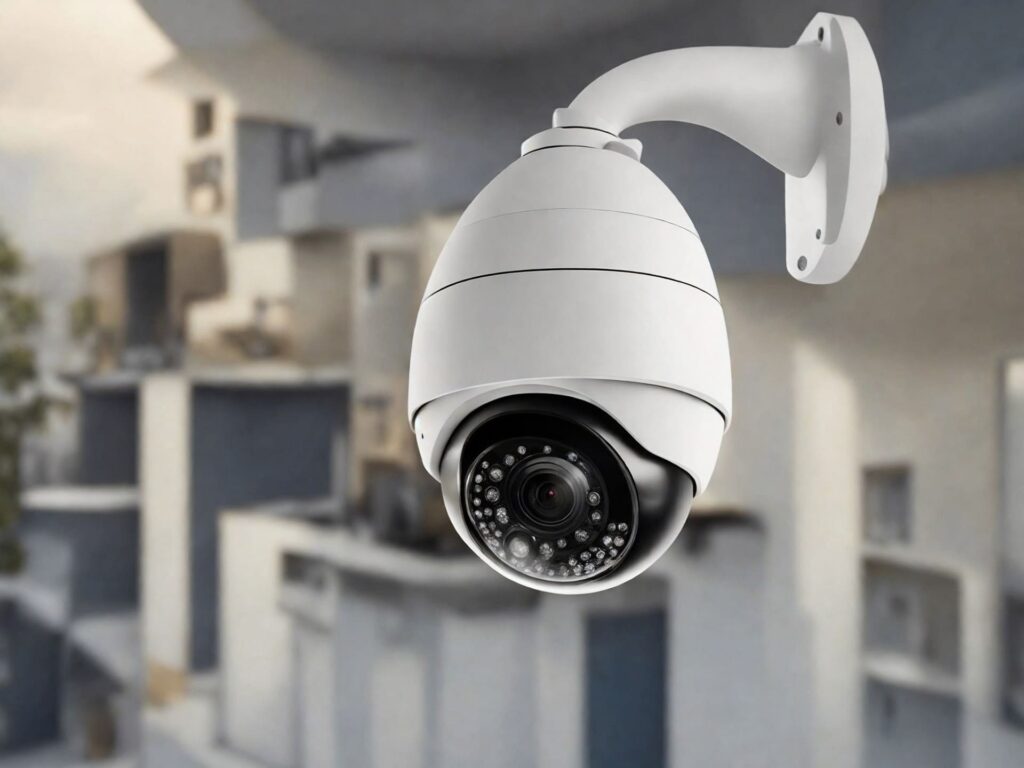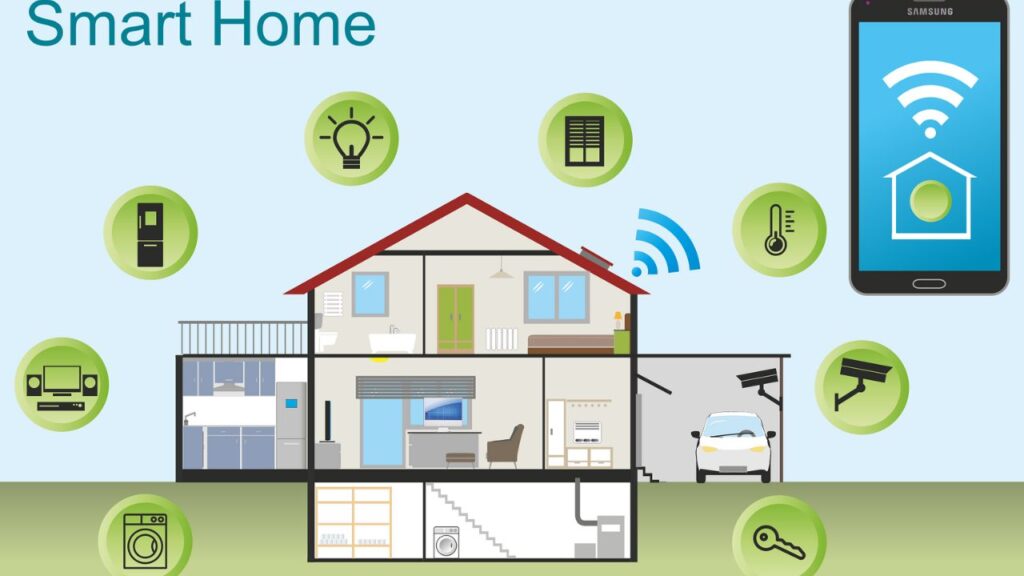In recent years, the idea of a “smart home” has undergone a rapid transformation. A trend of turning standard homes into interconnected and intelligent living spaces is on the rise. Due to technological advancements, it has become cost-effective and convenient to set up a smart home.
So, if you are a tech enthusiast and want to embrace the latest technology to have a smart home, this guide is for you. Here, we will discuss the basics of a smart home, how you can choose the appropriate smart components, and how to make your life easier and secure within a smart home ecosystem.
Understanding the Evolving Smart Home Technology
In this section, we will discuss the basics of a smart home along with the advantages that you can avail of.
Basics of Smart Home
A smart home is equipped with smart devices that can be automated and controlled from a virtual location. These devices are interconnected and communicate with each other through Wi-Fi. They perform specific tasks that are assigned according to the user preferences and preset conditions.
Since they are backed by modern technology, they offer convenience and control to the users. For example, home lightning can be managed through smart lights, which are managed through a smartphone app or voice assistant.
There are smart thermostats that can automatically adjust the temperature based on occupancy. Further, smart locks offer remote monitoring and control capabilities.
Advantages That You Can Avail
Smart homes offer convenience, accessibility, enhanced security, and energy efficiency. Various tasks such as lighting, safety, and temperature can be remotely controlled and automated through voice commands or smartphone apps.
This provides easy accessibility and independence to individuals, specifically those with disabilities. Further, smart locks and cameras can help to monitor real-time alerts, thereby enhancing security.
One of the advantages that smart homes provide, in comparison to traditional homes, is the energy efficiency. Smart devices can optimize energy usage because of their adjustment settings, making them cost-efficient and eco-friendly.
Starting with Setting Up a Smart Home
Setting up a smart home can sound exciting, but it needs a lot of research and planning so that you can get the most out of it. If you are just a tech enthusiast or want to make your life more convenient and secure, do careful analysis to prevent running out of budget.
1) Assessing Your Own Needs
Firstly, it is important to identify your goals and objectives behind opting for a smart home. Along with this, you should assess your needs, priorities, and budget since a smart home means a good amount of investment. These needs may include simplifying and automating daily tasks, enhancing security, or saving money on power bills.
Thus, you can start by selecting a few smart devices to check the functionalities and then add more according to your convenience. For instance, you can start with a combination of voice assistants, lightning, and thermostats. Later, you can add devices like smart locks, smart cameras, or entertainment systems, depending on your needs.
2) Compatibility of Devices
As stated, a smart home means to have an assembly of smart devices working seamlessly with each other in a particular ecosystem. Since all the smart devices may not be compatible with other smart devices, you need to cross-check while choosing the ecosystem. Connectivity is the basic thing that is needed to let devices “talk” and “coordinate” with each other.
So, select the primary device, such as a voice assistant, that can help you in setting up the smart home. According to the primary device chosen, you can further add new devices that are compatible with this device.
3) Scalability
Scalability is an important factor when setting up a smart home. This helps in future upgrades and the addition of new smart devices in the long term. You might think of expanding your home by constructing new rooms. Further, technology is evolving and so are more devices becoming smart.
In this scenario, the smart hub ecosystem chosen should be efficient enough to integrate with new devices and accommodations easily.
4) Budget
The costs that are involved with each system should be taken into consideration. These costs include the purchase of smart speakers or hubs, as well as any subscription fees that may be required for additional features or services.
Choose the Right Smart Home Devices
A smart home consists of various devices that can be controlled by any virtual assistant or through a smartphone app. Some of the smart home devices you can opt for are listed and described below. You can integrate these devices in one go or you can slowly add devices as per your convenience and budget.
1) Smart Hub
You can connect smart devices with Bluetooth, Wi-Fi, or a smart hub. While Bluetooth is relatively slower, Wi-Fi can be considered a good option. Way ahead of this is a smart hub that is much more responsive, offers stability and reduces congestion.
Just like the brain, a smart hub is a basic component of the smart home that helps smart devices communicate with each other. It integrates all devices and controls everything through a single app. The technology in the smart hub is of longer range, has lower bandwidth, and consumes less power.
While some smart hubs may function as standalone devices, others might have built-in technologies to connect the hub with various smart devices like routers, speakers, and displays. Some examples of smart hubs are Samsung SmartThings Hub, Google Home, and Amazon Echo Plus.
2) Network and Connectivity
A smart home relies on its networking as it requires a stable Wi-Fi connection with quality routers to let smart devices work together. While most smart devices can work on 2.4 GHz Wi-Fi frequency, 5 GHz frequency is needed for a longer range and fast speed.
Recently, a Wi-Fi protocol named Wi-Fi 6E has been launched that is more secure, consumes less power, and can handle more smart devices simultaneously. But for using this protocol, all your smart devices, including the mesh network, need to be compatible with the 6 GHz frequency band.
If you are living in an apartment, you can face congestion issues due to various Wi-Fi signals interfering with each other. To avoid this, you can use the app to find and switch to the best potential Wi-Fi network. Further, you should use routers that can support a good number of devices without hampering the overall performance of the network.
As per the privacy concerns, you can keep a strong and unique password for your Wi-Fi and router. Also, you can create and connect smart devices to a separate network for yourself and a guest network for the visitors.
3) Lighting
Smart light bulbs have the power to easily manage and adjust individual lights or even groups of lights with a single smartphone app. These cutting-edge smart bulbs provide convenient remote control, adjustable brightness, customizable colors, and the ability to set schedules.
This allows you to effortlessly create and elevate the perfect ambiance of your living space for any occasion. You have the option to configure them to activate and deactivate automatically, depending on various factors.
One of the great advantages is that they can be installed just like regular light bulbs, making it a hassle-free process. Philips Hue and LIFX have gained significant popularity due to their ability to adapt to your mood and seamlessly synchronize with music or movies.
4) Thermostat
With smart thermostats, you have the power to manage your air conditioning and heating right from your phone. These innovative devices take care of adjusting the temperature for you, considering factors such as the date and time, your present location, and the activity of connected devices.
They can detect whether you are at home or away, and they automatically make adjustments to optimize efficiency. Certain models utilize remote room sensors to ensure consistent heating and cooling in every corner of your home.
Installing smart thermostats is usually a straightforward process, although it does involve handling low-voltage wiring and may require some minor drilling. Devices such as the Nest Thermostat or Ecobee can effortlessly adapt heating and cooling settings to suit your preferences, ensuring your comfort while also conserving energy.
5) Security Camera

Smart security cameras offer advanced surveillance and monitoring features to improve home security. They have good camera resolution, large field of view, night vision capabilities, motion detection sensitivity, facilitate two-way communication, available cloud storage options for recording footage, and compatibility with other smart home security systems.
Both indoor and outdoor security cameras use advanced sensors to detect and record video of any sound or movement. Certain indoor cameras utilize motorized components to offer a comprehensive view of a room, along with the ability to store recordings.
Outdoor cameras are designed to endure harsh weather conditions, and certain models even include floodlights to brighten up driveways and backyards. However, it’s important to note that wiring may be required for installation.
Alternatively, opting for a wireless outdoor camera offers the advantage of being much easier to install. You can also go for smart video doorbells that help you keep a check on the movement near your door or the person who rang the doorbell. This enhances your security and prevents any theft or damage.
6) Smart Locks
Smart locks provide a convenient and secure way to enter your home without using keys, allowing for remote access control. You can easily control your locks remotely, provide temporary access to visitors, and seamlessly connect with other devices to create automated routines.
When selecting a smart lock, it’s important to take into account various factors such as ensuring compatibility with your door hardware, exploring different access methods (like a smartphone app, voice control, or keypad), evaluating the security features (such as encryption and tamper detection), and checking for integration capabilities with other smart home devices.
Thus, you can improve the security of your smart home by incorporating smart locks such as August or Schlage.
7) Voice Assistants
Voice assistants are the primary interface of a smart home that understands the command of the user and instructs the required device. While choosing the voice assistant, you should consider factors like compatibility with other smart devices, language and accent support, voice recognition accuracy, and privacy.
Three popular voice assistants used in smart homes include Google Assistant, Amazon Alexa, and Apple’s Siri. Here, we provide you with the details of these assistants so that you can opt for the one that fits your ecosystem.
a) Google Assistant
One of the recent virtual voice assistants is Google Assistant. It is supported by various Android devices, Google Home Smart speakers, and third-party devices. Since it can easily integrate with services of Google’s ecosystem (such as Calendar, Gmail, and Maps), this assistant offers more accurate and context-aware responses in various languages.
It is highly advanced and can leverage Google’s AI capabilities. Its robust integration with Google Nest helps to support various third-party smart home devices.
b) Amazon Alexa
The most commonly used voice assistant by smart home enthusiasts or tech enthusiasts is Amazon Alexa. It is integrated with Amazon’s Echo devices as well as third-party platforms and is compatible with a wide range of smart home devices.
It offers various third-party skills in multiple languages, helping users to extend functionalities for tasks such as controlling smart home devices. There are privacy settings that allow the user to get control of their privacy concerns.
c) Apple’s Siri
Apple’s Siri was the first renowned voice assistant that primarily integrates with Apple services and apps. It is supported by devices in the Apple ecosystem, such as iPhone, Mac, iPad, Apple Watch, and HomePod.
Though it works well with different third-party integrations, its ecosystem and integrations are not as extensive as those of Google Assistant and Amazon Alexa. It focuses on the user’s privacy and can interact in multiple languages with good localization support.
8) Smart Plugs
A smart plug helps you effortlessly convert everyday devices like fans, bulbs, and coffee makers into smart devices that can be controlled right from your phone. You can power them up by plugging them into a wall outlet, then download the app and easily connect your non-smart device.
With the help of a smart plug, you can enhance the functionality of your devices and make them more versatile. Certain smart plugs offer the convenience of voice commands and the ability to track your power consumption.
Some models are designed to withstand various weather conditions, making them perfect for outdoor spaces like patios or decks. Many plugs can also connect with other smart devices, allowing you to set up actions such as turning on a light when a security camera notices motion.
9) Smart Entertainment System
A smart entertainment system effortlessly combines technology with convenience, providing users with unmatched control and personalization. With the latest technology advancements, you now have the convenience of easily controlling your entire entertainment experience.
From voice-activated commands to user-friendly smartphone apps, managing entertainment has become easy. Whether it’s streaming music, binge-watching favorite shows, or immersing in cinematic experiences, the smart entertainment system caters to personal preferences.
The automated lighting and climate control synchronized with media playback seamlessly enhances the entertainment experience. It represents the perfect blend of innovation and comfort, encapsulating the essence of the contemporary smart home experience.
Various components that can power up your entertainment system include smart TVs, sound bars, and streaming devices. They help you play music or video using voice control as well as can integrate with other smart devices.
10) Other Smart Devices
Apart from the above-mentioned devices, various other smart devices can help your smart home look attractive while providing you with a convenient lifestyle.
–Smart Sensors
Smart sensors are transforming modern homes, providing unmatched convenience and efficiency. These devices, with their cutting-edge technologies such as artificial intelligence and Internet of Things (IoT) connectivity, are revolutionizing the way we engage with our living spaces.
With the help of advanced technology, various sensors have been developed to improve security and make daily tasks more convenient. Smart sensors can notice even slightest of the movement, measure temperature, check the lighting system, and notify you of water leaks. They can also communicate with other smart devices to change functionality as a response to the changing environment within your home.
–Smart Appliances
A smart home is equipped with smart devices in different spaces, including laundry rooms and the kitchen. Through the usage of internet connectivity, you can remotely control and automate smart appliances via voice commands or smartphone apps.
Modern appliances such as grocery-tracking refrigerators, remote-controlled washing machines, and preheating ovens while you’re on your way home are setting the standard. Thus, they help simplify the overall process, optimize energy usage, and provide consumption trends.
–Smart Curtains and Blinds
The natural lighting that reaches your space can easily be automated using smart curtains and blinds. There are options from various brands that help you set timers and adjust them according to the temperature, sunlight, and time of the day.
Further, you can create personalized schedules for different rooms. It offers a sense of security by giving a scenario of occupancy when you are not at home.
Setting Up the Network
Technology helps to bridge the innovation and convenience of a home into a smart home. So, while setting up the network, the following things should be taken into consideration.
1) Smart Home Protocols and Wi-Fi
When it comes to setting up your smart home, there are several important factors to consider to make the right choice for your networking technology. These factors include power consumption, range, reliability, and interoperability.
Wi-Fi provides fast internet access and works well with various devices, but it can experience issues like congestion and interference in densely populated geographical areas.
Smart home protocols like Bluetooth Low Energy (BLE), Z-Wave, and Zigbee are specifically designed for smart home applications. They bring benefits like energy savings, broadened range, and mesh networking capacity.
2) Router Configuration and Positioning
Ensuring consistent connectivity and maximum efficiency of your smart home devices heavily relies on an appropriate placement as well as configuration of the Wi-Fi router. It’s important to find a suitable spot for your router in your home, making sure it’s centrally located and free from any obstacles or electronic interference.
By configuring the settings of the router, the performance and security of your smart home devices can be optimized. This includes encryption methods, selecting the appropriate Wi-Fi channel, and setting up a guest network.
3) Network Security

To ensure the safety of your smart home network, it is crucial to take measures to protect against unauthorized access, information theft, and cyberattacks. You need to follow best security practices to protect your Wi-Fi network along with smart home devices.
This includes using strong and unique passwords, enabling network encryption, upgrading firmware and software regularly, and adding extra security measures like firewalls as well as intrusion detection systems.
For more security, opt for devices that support two-factor authentication. This means that it will confirm your account over an email or a text message. Alternatively, various devices need biometrics such as face recognition or fingerprint which prevents your connection from any intruder.
4) Safety Precautions
Along with network security, there are various safety precautions you need to take while setting up a smart home. Firstly, the privacy settings of all devices, along with the hub, should be reviewed and configured. These settings help to limit the data that is collected.
While installing devices, surge protectors should be used, and overloading electrical circuits should be avoided. Some smart devices have batteries and are prone to overheating. Thus, it is important to ensure that devices remain fire-compliant, thereby ensuring fire safety.
Further, you should know how to manually operate these smart devices in case of a network failure. Lastly, child-proofing these smart devices is necessary to prevent accidents.
Setup Guide for Smart Home Devices
Popular smart home brands offer easy compatibility of the devices with major ecosystems. They allow smart devices to be added directly to the Apple Home or Google Home apps. However, a third-party app is needed by most devices for the initial setup and configuration.
As a general setup guide, all smart devices need their companion app to be downloaded in the device through which you want to operate your smart home. You can either enter a serial number provided by the manufacturer or scan a QR code to run the process.
Though linking them to your existing ecosystem is essential, you can manually link them to any ecosystem. Google Home, Alexa, and Apple Home apps have simplified control for most smart devices. Thus, there is a possibility that you may have to use a third-party app to access particular settings.
Installing Smart Home Devices
A smart home with all the smart devices installed properly can give you a seamless experience of technology. Before jumping to the practical aspects, let us understand what factors are important in installing these devices.
1) Smart Installation
You can either go for professional installation or simply do it yourself. Before opting for any one of them, you need to consider your technical skills, budget, complexity, and time.
Going for professional installation helps you to get a reliable and hassle-free experience. But if you are going to install devices by yourself, you need to be a tech enthusiast and ready to devote time. Each device comes with an installation manual from the manufacturer.
By following those instructions, you can connect devices within the smart home network. After installation, make sure to check the configuration and test for their functionality.
2) Voice Assistance Setup
Voice assistants play a major role in the smooth functioning of devices in a smart home network. As discussed above, there are various popular voice assistants, and you can choose among them to build a perfect ecosystem.
Check the compatibility of your smart speaker or display with your voice assistant. Plug in the speaker and connect it to your Wi-Fi network using the instruction manual. Download the app of the voice assistant on your smartphone or device through which you want to connect all the smart devices remotely.
Create your Google account or Amazon account, depending on the assistant ecosystem. Through the app, search and link the smart devices. The next step is to train your voice assistant by helping it recognize your voice and commands for personalized responses and controlling the smart home.
3) Integration and Automation
Setting up your smart home refers to properly linking smart devices. You can enhance this capability by automating these devices. By installing a central hub or a voice assistant, you can control multiple devices remotely from a single smartphone app.
Creating automation rules for smart devices can be beneficial for you. These rules may consist of setting lights to turn on and off according to the time of the day. Thermostats can be adjusted when you enter or leave home. You can customize schedules like adjusting lighting and temperature according to your daily needs.
You can store voice commands and assign specific phrases for specific actions and tasks. These automation rules should be tested so to ensure the seamless functioning of the smart home network.
Now, we will discuss installing these devices according to your lifestyle and the existing design of your home. Though smart devices create a different atmosphere, they should blend with the décor of your home to offer you convenience.
1) Set devices according to the room
- The basic spaces of a particular home include a living room, kitchen, bedroom, bathroom, and home office.
- The living room is the center of a home and is generally related to your lifestyle reflection. Here, you can opt for smart lighting that effortlessly adapts to your moods and activities. Make sure that the entertainment system, including TV and soundbar, can be easily controlled using one smartphone app or through voice commands.
- Next, you can upgrade your culinary journey by incorporating the latest technology in the kitchen. For instance, a coffee maker or oven can be easily controlled through voice commands. A touchscreen hub can be added for easily accessing recipes and setting timers.
- Your bedroom is the place where you can relax and have a restful night. There are smart thermostats by which temperature can be regulated to have a good sleep. You can use alarm clocks embedded with voice technology that provide a gentle wake-up call.
- Coming to the bathroom, you can opt for smart mirrors that have built-in displays and can help you get ready in the morning. You can enjoy a spa-like experience by having a customized shower system with smart water settings.
- Assess your work needs and accordingly upgrade your home office with smart lighting and ergonomic furniture. You can enhance the security of the workspace with smart locks.
2) Clutter-free management
Despite being smart, you can’t get rid of wires that may make your home look cluttered. You can conceal cables and wires along baseboards and walls by using cable clips or raceways. A better option is to invest in furniture that already has built-in cable management solutions.
The integration of furniture should include selecting entertainment centers and shelving that comprises hidden compartments for wires, charging gadgets, and other electronic equipment.
Further, you can go for wall-mounted smart TVs and speakers to get rid of the hanging wires. You can use wire covers that are the same color as the room for a seamless appearance.
3) Maintaining home décor
Keeping up the aesthetics of your home while simultaneously incorporating intelligent and technological devices is a crucial component of timeless design. Make sure that the electrical devices purchased are simplistic and neutral in color. This will allow them to blend in with the existing home décor effortlessly.
For instance, you can choose smart speakers that not only offer you smartly enhance your entertainment experience but also act as decorative elements. Further, traditional switches can be replaced with smart switches without creating any disruption to the overall design of the room. You can try these hacks and tricks with other smart devices as well.
4) User-friendly atmosphere
Not everyone may be tech-savvy like you, so make sure that your smart home is user-friendly for one and all. For instance, set up voice assistants for remotely controlling these smart devices. These assistants may be Google Assistant, Amazon Alexa, or Apple’s Siri, according to the ecosystem chosen.
The smart devices should be configured to accommodate multiple users of different levels of technological expertise. Since smart homes are designed to simplify the management process, make sure that all smart devices can be managed through a single app. You can customize and automate these devices according to your usage and routine.
Putting labels on the controls can help in easily identifying the functionalities of each device. Written or video instructions should be provided to those who might need assistance with using devices.
Keeping in mind privacy and security concerns, a guest network, apart from a main network, may be developed for smart devices. The guests, during their stay, should be provided with easy instructions on how to connect smart home system.
Troubleshooting Issues
Though a smart home offers convenience and security, it might also bring some technical issues you need to deal with. Here, we discuss the possible issues and their solutions to streamline your experience of smart homes.
1) Connectivity Issues

It might be possible that devices face connectivity issues due to poor Wi-Fi signals. So, make sure that your smartphone and smart devices are connected with the same Wi-Fi band. This is because most smart devices, by default, need 2.4 GHz Wi-Fi.
Secondly, check the devices are closely connected to the router. If the box can’t be repositioned, try using a router extender. If the problem still persists, restart the router and the device. You can try updating to the new version of the device’s firmware.
In the case of a mesh network, ensure that all the nodes are connected and working properly.
2) Device Incompatibility and Malfunctions
Not all smart devices are compatible with each smart home ecosystem. Due to this, it is always recommended that you choose the appropriate device that fits the specific smart home setup you have opted for.
Also, you can use third-party tools such as IFTTT to synchronize devices. Further, you might face issues with voice commands or automation rules. While you set up a voice assistant, make sure to train it to recognize your voice and act accordingly.
The command should be given loud and clear with preset phrases for instructions to follow. If you see some tasks not starting automatically with your command, check the rules that have been set for automation.
You should test each device properly to find if they are connected. Otherwise, you can contact customer support if you are not able to detect the fault.
3) Security Concerns
When it comes to technology, you should take into consideration security concerns. To ensure that all the smart devices are functioning smoothly, remember to update the device’s firmware regularly. Your password should be strong and unique enough to prevent any intruder from causing a nuisance.
Avoid keeping the default passwords provided by the manufacturer or the company. Some smart devices offer two-factor authentication services to assure safety. Sensors and smart cameras should always be dust-free to work properly.
Regular practices you can opt for include restarting the router often, monitoring traffic for suspicious activity, and setting data collection limits.
Expanding Smart Home Setup
The technology is in its evolution phase leading to an increase in consumer demands. This fact applies to smart homes as well. Below are listed some points you might consider while expanding your smart home setup.
1) Installing New Devices
Your needs might change in the future, and you might consider enhancing your smart home setup. In that case, you might install additional devices or improve the existing ones.
Exploring and analyzing the devices that align with your needs is good, but you should also take into account the compatibility of those devices with the current setup. You can follow a similar setup process and configure the new devices to ensure convenience and a seamless experience in your smart home.
Further, if you are adding new devices, you should upgrade to a stronger router or a mesh network that can handle the increased load.
2) Exploring Advanced Features
After setting up your basic smart home, you might consider delving into the world of advanced features and integrations of smart devices. This helps you get home automation and enjoy the next level of convenience and functionality.
You can explore the possibilities of sensor-based triggers, automation routines, and enhancing smart home ecosystems by personalizing the experiences that match your lifestyle and preferences.
At the same time, be assured that if you have opted for a particular ecosystem, you should think of integrating features that are suitable for that ecosystem.
3) Engaging with Online Communities and Resources
Just like you, various tech enthusiasts have or are adopting smart home technologies. There are online forums, communities, and discussion pages where you can connect with those people.
Being part of these communities can help you gain valuable insights, inspiration, and support for your adaptation to a smart home from a traditional home. As you expand your smart home setup, there might be a threat to your security.
Thus, try to have a dedicated security solution well in hand. You can seek advice, exchange experiences, and stay informed about the latest technologies, products, security patches, and best practices to keep your smart home safe.
Conclusion
As technology continues to evolve and advanced systems drop now and then, there is an endless potential to create a smart home. No matter if you are a novice or tech-enthusiast, you can start your journey to turn your “home” into a “trendy, efficient, productive, and secure smart home.”
You can experience serenity along with utmost convenience by strategically assessing your needs, carefully choosing the right smart devices, and prioritizing security.
In a nutshell, a smart home is no more a symbol of a luxurious lifestyle. Instead, it is becoming increasingly popular among tech-savvy homeowners who are open to embracing new changes. Thus, smart homes hold the key to the future of traditional homes.
We hope you found the above smart home setup guide helpful. Make sure to share it with others by using the social media sharing buttons provided below.
Also Read:




